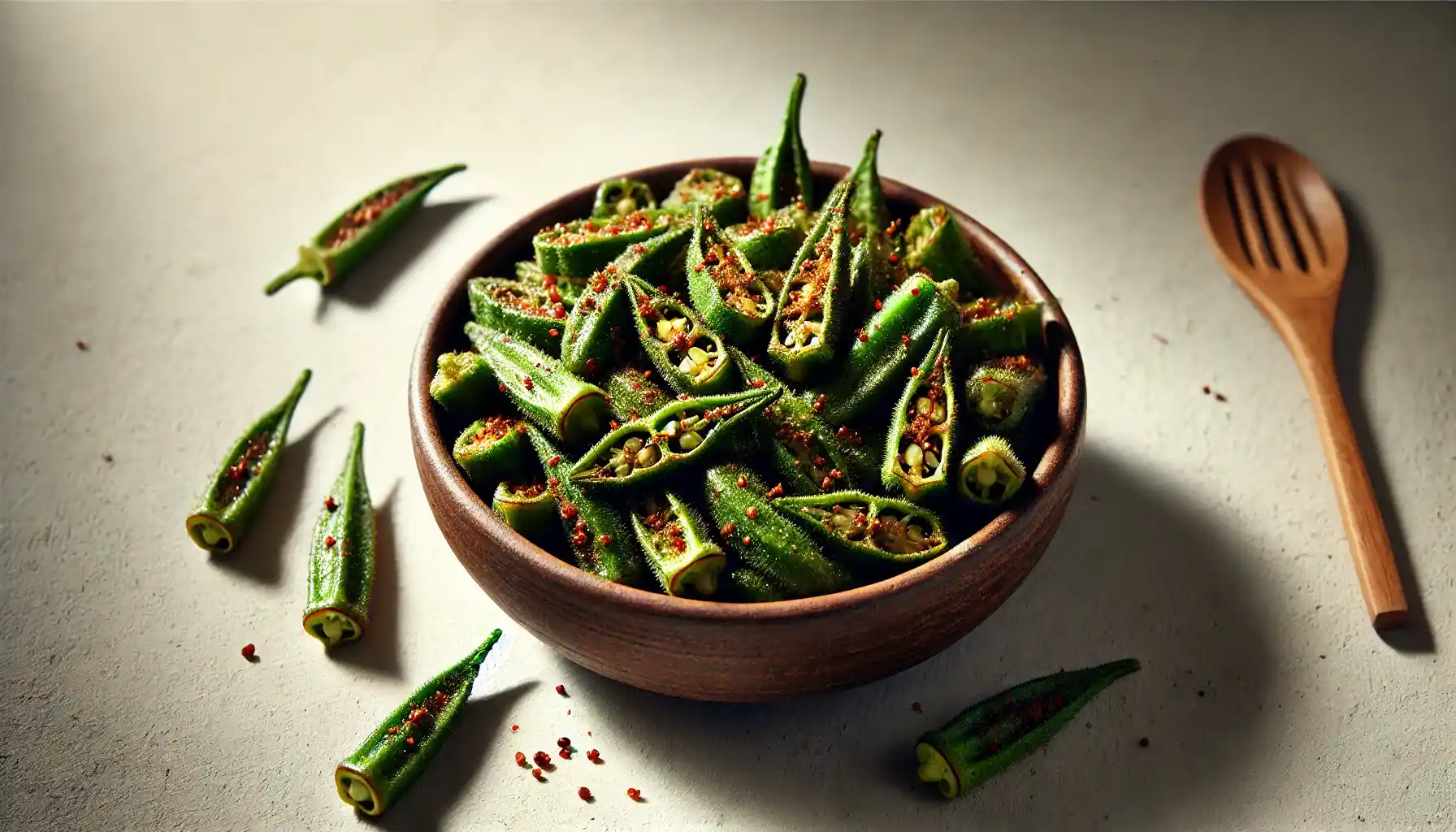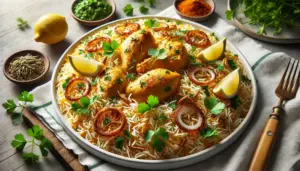Bhindi Fry, or Okra Fry, is a beloved Indian dish known for its rich flavor, satisfying crunch, and nutritional benefits. This dish combines the earthy flavors of okra with spices, making it an essential part of Indian meals. This comprehensive guide explores Bhindi Fry’s origins, detailed nutritional benefits, and the traditional recipe, providing insights into why it’s a must-have on your plate. From its health benefits to the perfect preparation techniques, this guide covers everything you need to know.
Nutritional Value of Bhindi (Okra)
Bhindi, or okra, is a powerhouse of essential nutrients, vitamins, and minerals. This low-calorie vegetable is especially appreciated for its high fiber content, which benefits digestion and helps maintain stable blood sugar levels. Below is the detailed nutritional breakdown of okra, emphasizing why it’s a fantastic choice for both taste and health.
Nutritional Profile of Bhindi (Okra) per 100g:
- Calories: 33 kcal
- Carbohydrates: 7g
- Protein: 2g
- Fiber: 3.2g
- Vitamin C: 23 mg (40% of the Daily Value)
- Vitamin K: 31 µg (41% of the Daily Value)
- Folate: 60 µg (15% of the Daily Value)
- Calcium: 82 mg
- Magnesium: 57 mg
- Potassium: 299 mg
- Iron: 0.8 mg
Health Benefits of Bhindi
- High in Fiber: The fiber in bhindi helps improve digestion, preventing constipation, and also contributes to feeling full longer, aiding weight management.
- Rich in Antioxidants: With antioxidants like flavonoids and polyphenols, okra supports immune health and combats oxidative stress in the body.
- Vitamin C Boost: High in Vitamin C, okra helps in strengthening immunity and skin health.
- Supports Bone Health: Okra’s Vitamin K and calcium content are essential for maintaining healthy bones and preventing fractures.
- Beneficial for Heart Health: The soluble fiber in okra assists in reducing bad cholesterol, while magnesium helps regulate blood pressure, making it heart-friendly.
- Low-Calorie, Nutrient-Dense: Bhindi is low in calories but high in nutrients, making it ideal for calorie-conscious diets without sacrificing essential vitamins and minerals.
Recipe for Bhindi Fry with Nutritional Value
This recipe offers a traditional Indian Bhindi Fry with a slight crunch and a perfectly spiced flavor profile. Enjoy this dish with chapati or rice for a delicious and nutritious meal.
Ingredients:
- Bhindi (Okra): 250 grams, washed and chopped
- Oil: 2 tablespoons
- Turmeric powder: 1/4 teaspoon
- Red chili powder: 1/2 teaspoon
- Coriander powder: 1 teaspoon
- Cumin seeds: 1/2 teaspoon
- Salt: as per taste
- Amchur powder (dry mango powder): 1/2 teaspoon (optional for tanginess)
Preparation Instructions:
- Prepare the Bhindi: Wash and dry the bhindi thoroughly. Slice it into small pieces, ensuring no moisture remains, as this helps prevent stickiness.
- Heat Oil and Add Spices: Heat oil in a pan, add cumin seeds, and let them splutter. Add the chopped bhindi.
- Season with Spices: Sprinkle turmeric powder, red chili powder, coriander powder, and salt. Stir gently to coat the bhindi evenly with spices.
- Cook the Bhindi: Sauté on medium heat, stirring occasionally, until the bhindi is golden brown and slightly crispy. This process may take 10-15 minutes.
- Add Amchur Powder (Optional): For a tangy flavor, add amchur powder and mix well.
- Serve: Bhindi Fry is best enjoyed hot with chapati, paratha, or rice, paired with a side of yogurt or raita.
Nutritional Value of Bhindi Fry (per serving)
This nutritional breakdown is based on a 125g serving of Bhindi Fry (half of the above recipe):
- Calories: 125 kcal
- Protein: 2.5g
- Carbohydrates: 10g
- Fiber: 4g
- Fat: 8g
- Vitamin C: 18 mg
- Vitamin K: 20 µg
- Folate: 45 µg
- Calcium: 65 mg
- Magnesium: 45 mg
- Iron: 1 mg
- Potassium: 200 mg
Tips for the Perfect Bhindi Fry
- Ensure Bhindi is Dry: Moisture can make bhindi sticky, so always pat it dry after washing.
- Cook on Medium Heat: Bhindi cooks best on medium heat for an even, crispy texture.
- Avoid Excess Stirring: Over-stirring can make bhindi mushy. Stir occasionally to prevent it from sticking but avoid continuous stirring.
- Add Gram Flour for Crispiness: For a crunchy texture, add a spoonful of gram flour (besan) while cooking.
- Use Amchur Powder for Tanginess: Amchur powder adds a subtle tang that complements the spices, enhancing the dish’s flavor.
Variations of Bhindi Fry
The beauty of Bhindi Fry lies in its versatility, with regional flavors and spices offering unique twists. Here are some popular variations:
- Classic Bhindi Fry: A simple recipe with minimal spices, highlighting the natural flavor of bhindi.
- Spicy Masala Bhindi: Adding extra spices like garam masala and green chilies creates a spicier version.
- Crispy Bhindi (Kurkuri Bhindi): Coat the okra in gram flour and spices, then deep-fry it for a snack or side dish.
- South Indian Bhindi Fry: With curry leaves, mustard seeds, and coconut, this version has a distinctly Southern taste.
Serving Suggestions and Pairings
Bhindi Fry pairs well with roti, chapati, or paratha. For a complete meal, serve it with steamed rice, dal, and a cooling side of raita.
- Mint Lemonade: A refreshing drink that balances out the spices.
- Mango Lassi: This sweet drink pairs beautifully with spicier bhindi fry.
- Chaas (Buttermilk): A traditional drink that aids digestion and complements the spices.
Fun Facts About Bhindi (Okra)
- Global Popularity: Known as “okra” in English and “gumbo” in Southern US cuisine, it’s used widely across various cuisines.
- Medicinal Uses: Okra has been valued in traditional medicine, especially in African and Indian cultures, for its benefits in digestion and inflammation.
- Historical Roots: Originally believed to have been cultivated in Africa, okra has traveled globally, finding a place in various culinary traditions.
Regional Variations and Cultural Significance
In different regions of India, Bhindi Fry takes on various forms, reflecting local ingredients and culinary traditions. For instance, in Maharashtra, adding a dash of goda masala offers a distinctive Maharashtrian flavor. In Rajasthan, bhindi is often served with bajra roti, creating a hearty and nutritious meal. Such regional variations showcase the adaptability and popularity of bhindi in Indian cuisine.
Conclusion
Bhindi Fry is a classic Indian dish that combines flavor, nutrition, and simplicity. Its versatility allows it to be prepared in many ways, making it adaptable for different tastes and preferences. Adding bhindi to your diet not only adds variety but also supports health through its rich fiber, vitamins, and minerals.
Enjoy Bhindi Fry as part of a wholesome meal, pairing it with Indian breads or rice. Whether prepared as a spicy masala or a crispy snack, this dish promises to be a flavorful and nutritious addition to your table.




